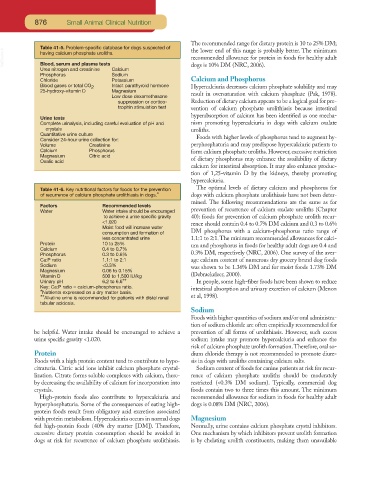Page 845 - Small Animal Clinical Nutrition 5th Edition
P. 845
876 Small Animal Clinical Nutrition
The recommended range for dietary protein is 10 to 25% DM;
Table 41-5. Problem-specific database for dogs suspected of the lower end of this range is probably better. The minimum
VetBooks.ir having calcium phosphate uroliths. recommended allowance for protein in foods for healthy adult
Blood, serum and plasma tests
Urea nitrogen and creatinine Calcium dogs is 10% DM (NRC, 2006).
Phosphorus Sodium
Chloride Potassium Calcium and Phosphorus
Blood gases or total CO 2 Intact parathyroid hormone Hypercalciuria decreases calcium phosphate solubility and may
25-hydroxy-vitamin D Magnesium
Low dose dexamethasone result in oversaturation with calcium phosphate (Pak, 1978).
suppression or cortico- Reduction of dietary calcium appears to be a logical goal for pre-
trophin stimulation test vention of calcium phosphate urolithiasis because intestinal
hyperabsorption of calcium has been identified as one mecha-
Urine tests
Complete urinalysis, including careful evaluation of pH and nism promoting hypercalciuria in dogs with calcium oxalate
crystals uroliths.
Quantitative urine culture
Consider 24-hour urine collection for: Foods with higher levels of phosphorus tend to augment hy-
Volume Creatinine perphosphaturia and may predispose hypercalciuric patients to
Calcium Phosphorus form calcium phosphate uroliths. However, excessive restriction
Magnesium Citric acid
Oxalic acid of dietary phosphorus may enhance the availability of dietary
calcium for intestinal absorption. It may also enhance produc-
tion of 1,25-vitamin D by the kidneys, thereby promoting
hypercalciuria.
The optimal levels of dietary calcium and phosphorus for
Table 41-6. Key nutritional factors for foods for the prevention
of recurrence of calcium phosphate urolithiasis in dogs.* dogs with calcium phosphate urolithiasis have not been deter-
mined. The following recommendations are the same as for
Factors Recommended levels
Water Water intake should be encouraged prevention of recurrence of calcium oxalate uroliths (Chapter
to achieve a urine specific gravity 40): foods for prevention of calcium phosphate urolith recur-
<1.020 rence should contain 0.4 to 0.7% DM calcium and 0.3 to 0.6%
Moist food will increase water
consumption and formation of DM phosphorus with a calcium-phosphorus ratio range of
less concentrated urine 1.1:1 to 2:1.The minimum recommended allowances for calci-
Protein 10 to 25% um and phosphorus in foods for healthy adult dogs are 0.4 and
Calcium 0.4 to 0.7%
Phosphorus 0.3 to 0.6% 0.3% DM, respectively (NRC, 2006). One survey of the aver-
Ca:P ratio 1.1:1 to 2:1 age calcium content of numerous dry grocery brand dog foods
Sodium <0.3% was shown to be 1.36% DM and for moist foods 1.73% DM
Magnesium 0.06 to 0.15%
Vitamin D 500 to 1,500 IU/kg (Debraekeleer, 2000).
Urinary pH 6.2 to 6.6** In people, some high-fiber foods have been shown to reduce
Key: Ca:P ratio = calcium-phosphorus ratio. intestinal absorption and urinary excretion of calcium (Menon
*Nutrients expressed on a dry matter basis.
**Alkaline urine is recommended for patients with distal renal et al, 1998).
tubular acidosis.
Sodium
Foods with higher quantities of sodium and/or oral administra-
tion of sodium chloride are often empirically recommended for
be helpful. Water intake should be encouraged to achieve a prevention of all forms of urolithiasis. However, such excess
urine specific gravity <1.020. sodium intake may promote hypercalciuria and enhance the
risk of calcium phosphate urolith formation.Therefore, oral so-
Protein dium chloride therapy is not recommended to promote diure-
Foods with a high protein content tend to contribute to hypo- sis in dogs with uroliths containing calcium salts.
citraturia. Citric acid ions inhibit calcium phosphate crystal- Sodium content of foods for canine patients at risk for recur-
lization. Citrate forms soluble complexes with calcium, there- rence of calcium phosphate uroliths should be moderately
by decreasing the availability of calcium for incorporation into restricted (<0.3% DM sodium). Typically, commercial dog
crystals. foods contain two to three times this amount. The minimum
High-protein foods also contribute to hypercalciuria and recommended allowance for sodium in foods for healthy adult
hyperphosphaturia. Some of the consequences of eating high- dogs is 0.08% DM (NRC, 2006).
protein foods result from obligatory acid excretion associated
with protein metabolism. Hypercalciuria occurs in normal dogs Magnesium
fed high-protein foods (40% dry matter [DM]). Therefore, Normally, urine contains calcium phosphate crystal inhibitors.
excessive dietary protein consumption should be avoided in One mechanism by which inhibitors prevent urolith formation
dogs at risk for recurrence of calcium phosphate urolithiasis. is by chelating urolith constituents, making them unavailable

